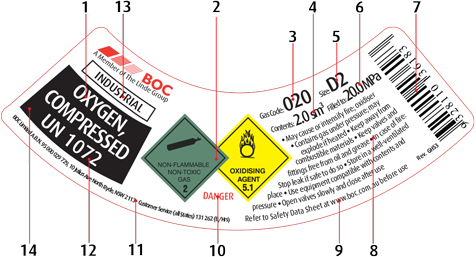Gas Cylinder Size Identification
BOC cylinder sizes are denoted by a letter code. The gas content of cylinders is measured in cubic metres, litres or kilograms. If volume unit is given, it refers to standard temperature and pressure of 15°C (101.3 kPa). The illustration below is provided to give an approximate indication of cylinder heights in relation to the average person.

Common Layout of Shoulder Labels
The gas name label, stencilling or component details should always be used to identify the contents of cylinders. Labels must not be removed or defaced. Any cylinder without a gas name label should be returned to the supplier for replacement.

| No. | Description |
|---|---|
| 1 | Gas name (UN proper shipping name) |
| 2 | Dangerous goods classification |
| 3 | BOC gas code |
| 4 | Contents of cylinder at standard temperature and pressure (15°C @ 101.3 kPa) |
| 5 | Cylinder size |
| 6 | Fill Pressure |
| 7 | Material barcode |
| 8 | GHS hazard and precaution statements |
| 9 | Safety Data Sheet location |
| 10 | GHS signal word |
| 11 | Customer Engagement Centre contact details |
| 12 | United Nations numbering system for safe handling, transport and storage |
| 13 | Gas grade |
| 14 | Please note: Black background only applies to industrial oxygen |
* Always refer to Safety Data Sheets (SDS)